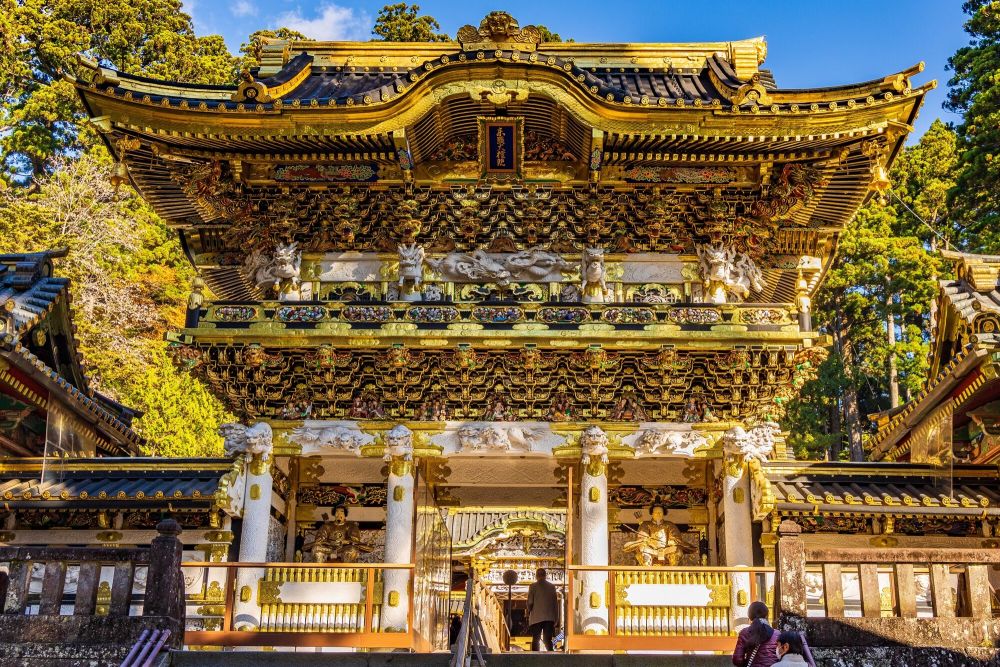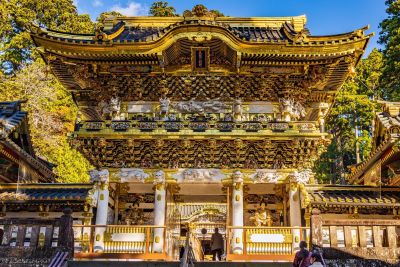

Explore the rich history and remarkable architecture of Toshogu Shrine with a knowledgeable guide leading the way. This comprehensive tour delves into the life and legacy of Tokugawa Ieyasu, the founder of the Tokugawa shogunate, whose remains are enshrined here. Participants will marvel at the lavish decorations, intricate carvings, and beautiful lacquer work that adorn the various buildings, including the famous Yomeimon Gate. The guide will explain the religious significance and the syncretism of Shinto and Buddhist practices represented at the shrine. Visitors will also have a chance to see the renowned 'See No Evil, Speak No Evil, Hear No Evil' monkey carvings, as well as the sleeping cat, and the stable of sacred horses. This engaging tour is essential for understanding the cultural importance of Toshogu Shrine in Japanese history.
Experience the traditional art of Japanese calligraphy at Toshogu Shrine. Under the guidance of an experienced instructor, learn how to hold the brush and practice the strokes used to create the beautiful characters of the Japanese language. This activity is not only an art lesson but also a meditative practice that has been an integral part of Japanese culture for centuries. Participants will have the opportunity to write their names or favorite words in kanji and take their artwork home as a unique souvenir. The serene surroundings of the shrine provide the perfect backdrop to connect with Japan's cultural heritage through the delicate and disciplined art of calligraphy.
Throughout the year, Toshogu Shrine hosts a number of traditional festivals that visitors can enjoy. Notable events include the Spring and Autumn Grand Festivals, which feature a procession of over a thousand people dressed in elaborate samurai costumes. The shrine's festivals often involve sacred dances, music, and rituals that have been performed for hundreds of years. These events are a fantastic way to immerse oneself in the living history and customs of Japan. Additionally, during specific festivals like the Yayoi Festival in April, visitors can witness the beautiful cherry blossoms, adding to the magical experience. Each festival offers a unique glimpse into the shrine's significance to the local community and visitors alike.
Toshogu Shrine offers a visual feast for both amateur and professional photographers alike. By joining a photography tour, participants can learn how to capture the beauty of the shrine's intricate designs, lush forests, and ornate structures. Guides often provide tips on finding the perfect angles and using natural light to enhance the majourniqueness of each shot. Beyond snapping photos of the famous sights like the Five-Storied Pagoda and sacred Shinkyusha, photographers can seek out lesser-known spots within the shrine's grounds for unique compositions. With the changing seasons providing a myriad of colors and atmospheres, every visit offers new photographic opportunities.
Join a meditation session at Toshogu Shrine to experience spiritual serenity amid the natural beauty of Nikko. Conducted by shrine priests or meditation practitioners, these sessions help visitors connect with their inner selves and the tranquil environment of the shrine. Participants will be guided through breathing techniques and mindfulness practices that are rooted in Japan's Zen traditions. Whether seated indoors or within the shrine's gardens, individuals can take this time to reflect and find peace away from the bustle of everyday life. This spiritual activity is a unique chance to embrace the calm and contemplative aspects of Japanese culture in a setting that has been a place of worship and reflection for centuries.
Experience a traditional Japanese tea ceremony at the historical Toshogu Shrine. The tea ceremony, or 'chanoyu', is a highly ritualized practice of preparing and serving matcha, a powdered green tea. Participants will be invited to a tea house within the shrine's grounds, where a tea master will demonstrate the profound philosophies of harmony, respect, purity, and tranquility that underpin the ceremony. The precise movements and careful attention to detail offer insight into the wider aesthetic sensibilities of Japanese culture. Guests will learn about the history of the ceremony and the utensils used before enjoying a bowl of matcha, accompanied by a seasonal sweet to balance the tea's bitterness. This quintessential Japanese activity provides a moment of reflection and appreciation for the simpler aspects of life.
For visitors eager to learn about Shinto practices, the Shrine Etiquit Workshop at Toshogu Shrine is an enlightening hands-on experience. Through this workshop, participants will gain a deeper understanding of the rituals and customs associated with visiting a Shinto shrine. Instructors will demonstrate the proper way to cleanse oneself at the temizuya (purification fountain), how to offer prayers at the main hall, the significance of tossing a coin into the offering box, and the correct way to bow respectfully before the deities. Emphasizing the cultural importance of these traditions, the workshop ensures that visitors can participate in shrine visits throughout Japan with confidence and respect.
The natural beauty surrounding Toshogu Shrine changes with the seasons, making it an ideal backdrop for seasonal nature walks. Visitors can enjoy guided walks that explore the different flora and fauna found in the area. From the vibrant colors of autumn leaves to the soft hues of spring blossoms, the shrine's gardens and nearby forests are a showcase for Japan's seasonal transformations. Guides on these walks will discuss the different plant species and their cultural significances, as well as point out historic and natural landmarks. This leisurely activity is perfect for those looking to combine an appreciation of nature with the cultural and spiritual context of the shrine.
Toshogu Shrine occasionally hosts various cultural performances that share Japan's rich performing arts heritage with visitors. These events may include Noh theatre, known for its stylized masks and slow, expressive movements, or traditional music concerts featuring instruments like the koto, shamisen, and shakuhachi. Such performances are often held during festivals or special occasions and provide an immersive cultural experience. The striking backdrop of Toshogu Shrine enhances the atmosphere, allowing the audience to feel transported back in time. Watching these performances is not only entertaining but also an excellent opportunity to further understand the aesthetic sensibilities of Japanese culture.
No visit to Toshogu Shrine would be complete without browsing the selection of souvenirs and local handicrafts available at nearby shops. Visitors can purchase items such as Yosegi-zaiku, a form of traditional Japanese marquetry made from local woods, or beautiful Edo Kiriko glassware. Other popular souvenirs include omamori (charms) for good luck; ema, small wooden plaques for writing prayers and wishes; and shuin, unique shrine stamps collected in a special book. These items serve as a tangible memory of the pilgrimage to Toshogu and a chance to support local artisans who have honed their craft for generations. Shopping for souvenirs is a leisurely activity that both honors traditional arts and allows you to bring a piece of Japanese culture back home.
